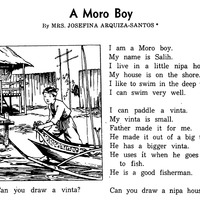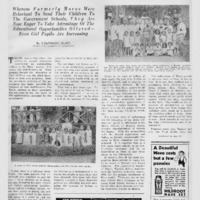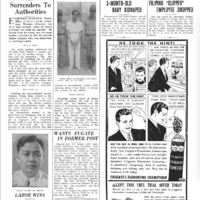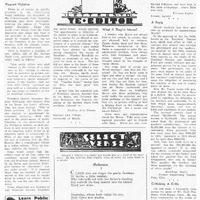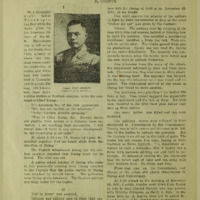The American period saw a proliferation of periodicals in different languages. Some of the English-language newspapers and periodicals that came out during this time are still being published today, such as the Manila Bulletin and Graphic. As the Americans promoted public education, the English language became more accessible to Filipinos, yet its position as the language of schooling and government came largely to the detriment of local languages for official purposes. Until the present day, the English language is still used extensively in the Philippines for political and academic discourses. For studying representation, English-language discourses provide a rich source of data that links identity-based representations in today’s current global anglosphere and the American colonial era.
Upon the handover of the Philippines through the Treaty of Paris in 1898, the Americans inherited a colony that had still not been fully consolidated territorially and demographically. Areas of resistance remained both in the far North (Cordillera region) and South, inhabited by Moros. Both regions were subjected to a military regime as opposed to the civilian one that was responsible for the administration of the Christianized areas of the country (Abinales 2010). The Americans are largely credited with introducing a comprehensive system of public education in the Philippines, which they expanded to include ‘Moroland’. At the same time, the American colonial era saw the rise of Moro elites who built close political ties with the American colonial government and who were encouraged to study in the capital and other large cities. As with the ilustrados, the Moro elites and middle classes were represented in the media to be largely responsible for the introduction of ideas from the capital to their own localities.
A poem depicting a way of life far removed from Christian Filipinos and urban centers.
With regard to public education, the Americans had always viewed the Filipinos as in need of civilization, even re-education from the Spanish, a belief that appeared in several American-based publications (Angeles 2010). This also included mentions of the Moro in publications targeted towards younger audiences, such as The Young Citizen.
Equally important was the fact that publications that appeared during the American period often include news about Moros so as to consolidate the wholeness of the colony. The collection of articles presented here, for instance, show that while Moros were ethnically identified when committing crimes, they were simultaneously encouraged to assimilate into the civil and military life of the Philippines. In particular, education was regarded as an important tool for achieving American objectives. According to Milligan (2005), Moro fears of American education at the time were largely directed towards their socialization into a particular way of life, for not only were Americans socializing Moros into the governmental and educational system of Christian Filipinos, but also they simultaneously wanted to de-culturalize Moros from their traditions, practices and modes of administering land and socio-political relations (63-65, 83).
In a Graphic article about the education of Moros, conformity with colonial goals is lauded, while others show the voluntary payments of the land tax. The policy of assimilation into the governing structures of colonial Philippines, however, did not necessarily result in harmony between various cultural communities. In contrast with the article opening this page, which shows differences between datus and ‘educated Moros’ about the recruitment of Moros into the military, an article reveals the desire for an American governor over a Moro or a Christian Filipino due to the political instability the latter were perceived to cause.
An article on the state of education among Moros.
An excerpt from daily news reports on the payment of land taxes.
An article on the desire for an American governor.
The discourse of the time often refers to matters of compliance and integration into the American colonial system and government structures. Moros were thus frequently represented in everyday news as uncivilized and violent, and only those who were integrated into the American system and conformed with the colonial regime were given favorable treatment. In sum, Moros were viewed positively insofar as they were ‘assimilated’. At the same time, while some articles presented Moros as an inherently belligerent ‘race’, army publications valorized their battles with Moros. The situation was lamented in a letter published in Graphic, “What if they’re moros?”, which decried the poor public perception of Moros.
An article generalizing traits of people in Jolo and Lanao
A letter to the editor on the negative perceptions towards Moros
Criticism of American prejudices against the Chinese
At this point, the Tagalog term in-chek (meaning ‘his uncle’), which derived from Minnan language, came to be used for the Chinese: ‘insic’ or ‘intsik’ henceforth became a colloquial term, although it was also critiqued for its derogatory connotations (Chu 2021).
The US acquired the Philippines in 1898, sixteen years after the Chinese Exclusion Act of 1882, which prevented for 10 years the immigration to the US of all Chinese laborers. In 1902, the act was expanded to include both Hawaii and the Philippines. The US limitation of the migration of East Asians were combined with a racial conception of society (Tourse et al. 2018) which discouraged intermarriage and supported racial segregation, either through laws or outright prejudice in daily life.
An article decrying the privileging of ‘foreign’ businesses
Meanwhile, in the Philippines, the decision to exclude Chinese from immigration was met with support by the Union Obrera Democratica (UOB) (Chu 2021). The main reason for celebrating the American exclusion act was the competition that Chinese-owned businesses posed to non-Europeans and non-Chinese.
Citing racial belongingness as the basis for nationhood was not an idea that emerged during the American period. However, during this period, as it combined with fears of economic rivalry that echoed those of the Spaniards, the discourses of suspicion, rivalry and foreignness began to be applied to Chinese residents of the Philippines, regardless of how long they had lived in the country, or their religion.
Bibliographic references
Abinales, Patricio. 2010. Orthodoxy and History in the Muslim-Mindanao Narrative. Quezon City: Ateneo de Manila University Press.
Angeles, Vivienne SM. 2010. “Moros in the Media and beyond: Representations of Philippine Muslims.” Contemporary Islam 4: 29–53.
Chu, Richard T. 2021. “From ‘Sangley’ to ‘Chinaman’, ‘Chinese Mestizo’ to ‘Tsinoy’: Unpacking ‘Chinese’ Identities in the Philippines at the Turn of the Twentieth-Century.” Asian Ethnicity.
Milligan, Jeffrey Ayala. 2005. Islamic Identity, Postcoloniality and Educational Policy: Schooling and Ethno-Religious Conflict in the Southern Philippines. New York/London: Palgrave Macmillan.
Tourse, Robbie W.C., Johnnie Hamilton-Mason, and Nancy J. Wewiorski. 2018. Systemic Racism in the United States: Scaffolding as a Social Construction. Cham: Springer.


